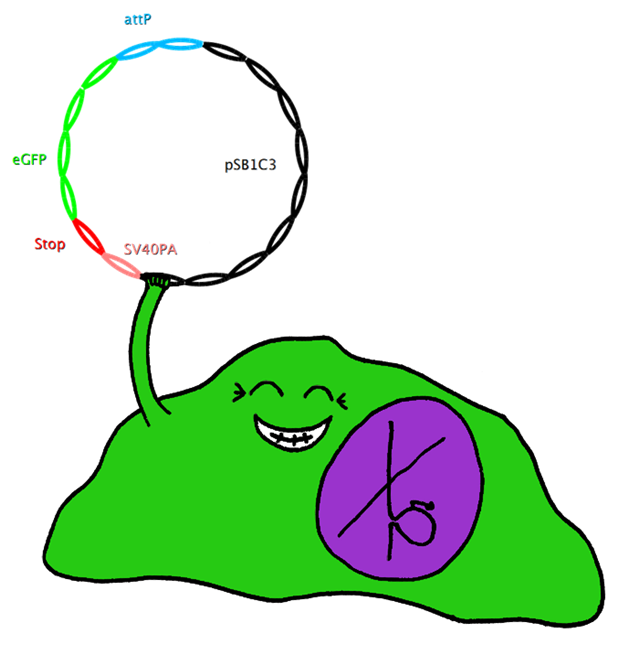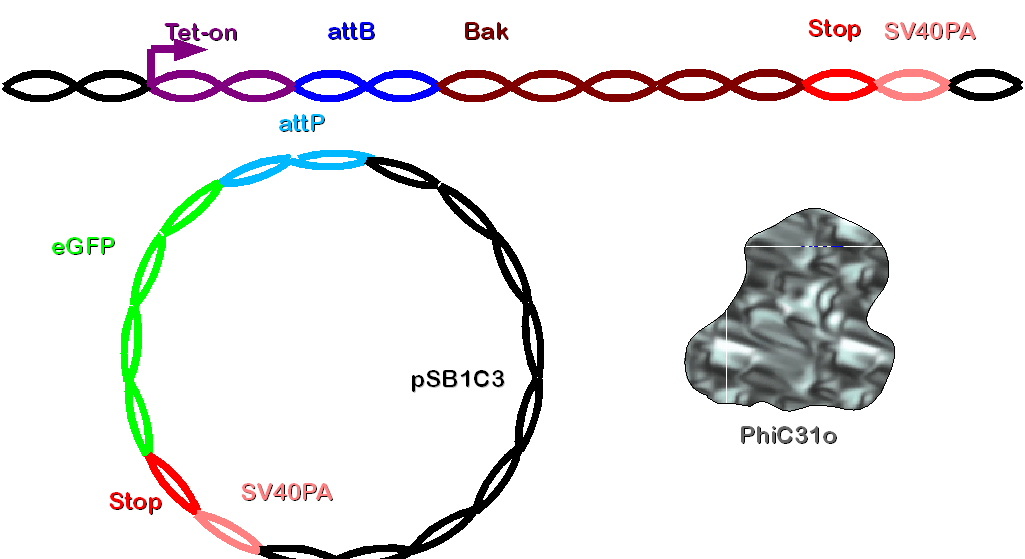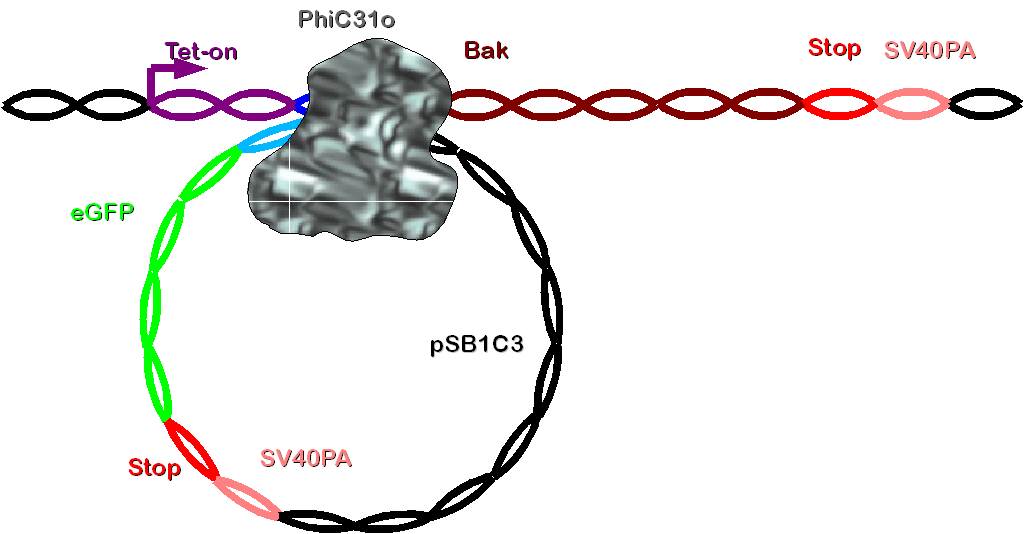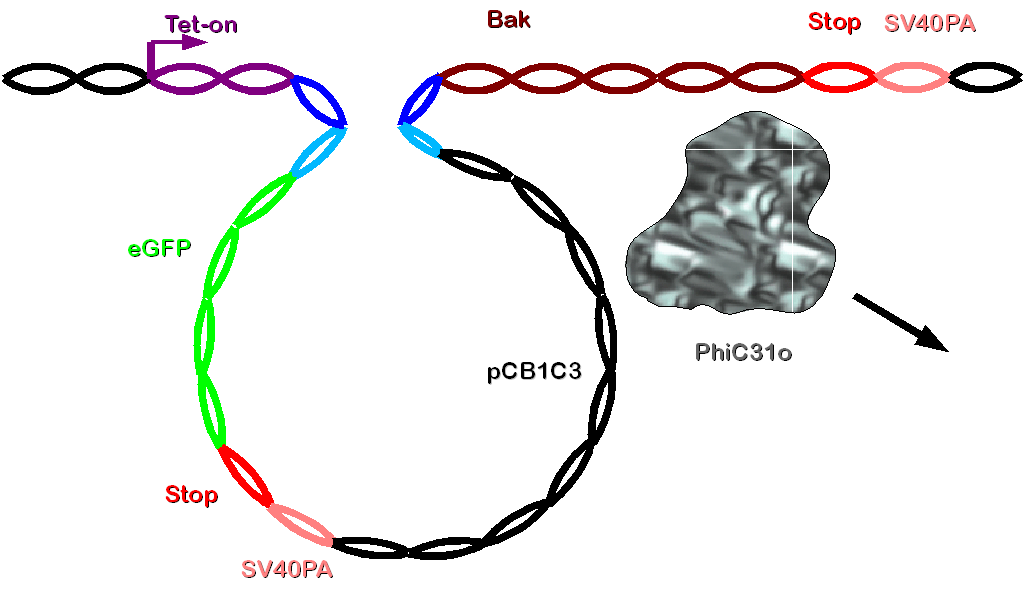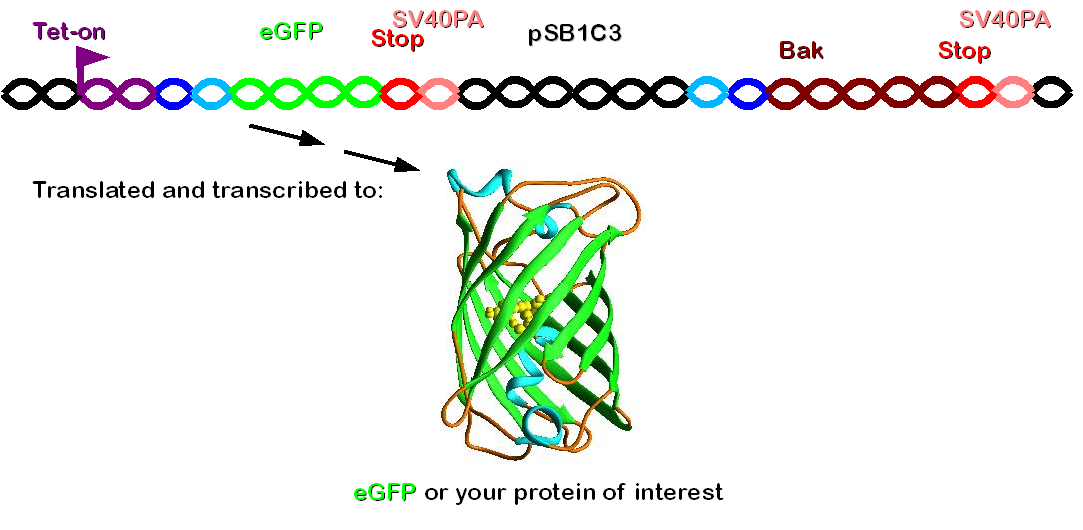Team:LMU-Munich/Jump-or-die
From 2010.igem.org
(New page: {{:Team:LMU-Munich/Templates/Page Header}} {{:Team:LMU-Munich/Templates/Page Footer}}) |
(→Jump-or-Die System) |
||
| (8 intermediate revisions not shown) | |||
| Line 1: | Line 1: | ||
{{:Team:LMU-Munich/Templates/Page Header}} | {{:Team:LMU-Munich/Templates/Page Header}} | ||
| + | == Jump-or-Die System== | ||
| + | |||
| + | [[image:Jumplogo.png|300px|right|ApoControl logo]] | ||
| + | |||
| + | This system also uses Bak as apoptosis inducing selection marker together with the Tet-on promoter, which is to be stably integrated in the cell-line genome. However, this construct also includes an upstream bacterial attachment site (attB) and a downstream SV40 polyadenylation site (SV40PA). The target gene eGFP is combined with phage attachment site (attP) and another SV40PA but without promoter. The target plasmid is co-transfected with integrase PhiC31o into the cell line. Therefore the target gene can only be expressed if integrated into the cells’ genome, and the stop-codon and SV40PA following the target gene stop the expression of bak, ensuring the survival of the cell while other cells not expressing the target gene undergo induced apoptosis. | ||
| + | |||
| + | For more details of the functional principle, please click: [[Team:LMU-Munich/Jump-or-die/Functional_Principle|Jump-or-Die Functional Principle]] | ||
| + | |||
| + | |||
| + | PhiC31o will be read off because of CMV promoter. Now the integrase will combine attB and attP site and integrate construct 2 into the genome. Now the gene of interest is integrated between the tet-on promoter and bak in the cellular genome. This complex will be translated after tetracycline induction. The doubled stop codon and polyadenylation site directly after eGFP (the gene of interest) will efficiently prevent the translation of bak. Thus such cells will express the gene of interest and survive. | ||
| + | |||
| + | [[Image: Dnajump4.PNG | 600px | Jump recombination]] | ||
| + | |||
| + | [[Image: Dnajump8.PNG |center| 200px | Jump recombination]] | ||
| + | |||
| + | [[Image: Dnajump5.PNG | 600px | Jump recombination]] | ||
| + | |||
| + | [[Image: Dnajump8.PNG |center| 200px | Jump recombination]] | ||
| + | |||
| + | [[Image: Dnajump6.PNG | 600px | Jump recombination]] | ||
| + | |||
| + | [[Image: Dnajump8.PNG |center| 200px | Jump recombination]] | ||
| + | |||
| + | [[Image: Dnajump7.PNG | 600px | Jump recombination]] | ||
| + | |||
| + | |||
| + | |||
| + | [[image:Jumplogo.png|250px|right|ApoControl logo]] | ||
| + | |||
| + | |||
| + | |||
{{:Team:LMU-Munich/Templates/Page Footer}} | {{:Team:LMU-Munich/Templates/Page Footer}} | ||
Latest revision as of 14:39, 25 October 2010
This system also uses Bak as apoptosis inducing selection marker together with the Tet-on promoter, which is to be stably integrated in the cell-line genome. However, this construct also includes an upstream bacterial attachment site (attB) and a downstream SV40 polyadenylation site (SV40PA). The target gene eGFP is combined with phage attachment site (attP) and another SV40PA but without promoter. The target plasmid is co-transfected with integrase PhiC31o into the cell line. Therefore the target gene can only be expressed if integrated into the cells’ genome, and the stop-codon and SV40PA following the target gene stop the expression of bak, ensuring the survival of the cell while other cells not expressing the target gene undergo induced apoptosis.
For more details of the functional principle, please click: Jump-or-Die Functional Principle


![]()
![]()







![]()
![]()

![]()
Jump-or-Die System
PhiC31o will be read off because of CMV promoter. Now the integrase will combine attB and attP site and integrate construct 2 into the genome. Now the gene of interest is integrated between the tet-on promoter and bak in the cellular genome. This complex will be translated after tetracycline induction. The doubled stop codon and polyadenylation site directly after eGFP (the gene of interest) will efficiently prevent the translation of bak. Thus such cells will express the gene of interest and survive.
![]()
![]()

 "
"
